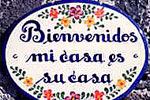|
||||||||||||||||||||||||||||||||||||||||||||||||||||||||||||||||||||||||||||||||||||||||||||||||||||||||||||||||||||||||||||||||||||||||||||||||||||||||||||||||||||||||||||||||||||||||||||||||||||||||||||||||||||
 |
||||||||||||||||||||||||||||||||||||||||||||||||||||||||||||||||||||||||||||||||||||||||||||||||||||||||||||||||||||||||||||||||||||||||||||||||||||||||||||||||||||||||||||||||||||||||||||||||||||||||||||||||||||
 |
||||||||||||||||||||||||||||||||||||||||||||||||||||||||||||||||||||||||||||||||||||||||||||||||||||||||||||||||||||||||||||||||||||||||||||||||||||||||||||||||||||||||||||||||||||||||||||||||||||||||||||||||||||
Indicating Possession in Spanish
Using DeIn English when we want to indicate that something belongs to someone we add an apostrophe and an "s" to their name. For example: Susana's book We cannot do the same in Spanish. There is no apostrophe in Spanish and adding an "s" just makes things look plural. Instead we need to use the following formula including the word de (meaning "of"): article + noun + de + name Note: You can also use general nouns instead of names: el equipo de la escuela Like this: el libro de Susana Simple enough, right? But we don't always use people's names to indicate possession. Possessive AdjectivesYou don't normally think of them this way, but words like "my," "your," "our," and "their" are actually adjectives. They do, after all, modify nouns like any other adjective: the red car my car In fact they are known as "possessive adjectives." Here are all of the English possessive adjectives:
Bonus Lesson: How to Use "Y'all" Correctly Notice that no distinction is made between the singular and plural forms of the second person (although in some parts of the United States "you all's" or "y'all's" would not look out of place in the plural column.) In Spanish, as in English, there are two types of possessive adjectives: short form and long form. We'll look at the short form first: Short Form Possessive Adjectives in SpanishIn Spanish the basic short form possessive adjectives look like this:
You may be wondering why tu doesn't have the accent you're accustomed to seeing. Remember the word tú is a subject pronoun and means "you." The word tu (without the accent) is an adjective and means "your." Understanding this distinction is very important. Note that, as with subject pronouns, the second person makes a distinction between formal and informal situations. Also note that the bottom two rows are identical. Because of this we're going to simplify our possessive adjective chart a bit, just like we do with verb conjugation charts:
We use short form possessive adjectives in Spanish the same way we do in English. We place the adjective in front of the noun. The formula looks like this: (short form) possessive adjective + noun Some examples:
If the examples above look pretty straightforward, they're only the basic forms. Like any good Spanish adjective, possessive adjectives need to agree in number so we have some variations for plural forms:
Now would be a good time to talk about what we mean by "plural" in this situation. The plural form is used when we have more than one thing being possessed, not when we have more than one possessor:
In the first example, since there is more than one car, "my" is translated in the plural mis even though there is only one of me. Similarly in the second example, "your" is translated in the plural tus even though there is only one of you. In the last example there is more than one of us, but we use the singular nuestro because this time there is only one car. If you can remember that adjectives (even possessive adjectives) only agree with the nouns they modify, this concept shouldn't be too difficult. But now it's going to start to get complicated, because Spanish adjectives also need to agree in gender. Look at our (simplified) chart again:
We can't really change the "i" in mi from one gender to another since "i" is gender-neutral. The same thing can be said for the "u" in both tu and su. We can, however, change nuestro and vuestro from their current masculine states to feminine ones which means we have even more variations:
As with singular and plural, we pick a masculine or a feminine adjective based on the gender of the thing(s) being possessed, not the gender of the possessor:
In the first example nuestra agrees (in gender and in number) with the noun it modifies, bicicleta, and has nothing to do with the fact that it belongs to a group of girls. You'll notice that changing the ownership to a group of boys does nothing to the phrase because the noun being modified is still bicicleta (singular and feminine). Likewise in the last example nuestros agrees in gender and in number with libros and has nothing to do with the girls (gender or number) who own the books. Ambiguity With Su and SusHow would you translate these phrases? su camisa su coche sus llaves Looking at our charts we see that su and sus could mean "his," "her," "its," "your" (in the Ud. or Uds. form), or even "their." While there wouldn't be much confusion with any of the other possessive adjectives, su and sus cause some trouble since they can mean so many different things. What do Spanish-speaking people do in order to be understood? First of all, context will take care of most of these kinds of problems. If these phrases popped-up in a conversation about Gloria, for example, it would be fairly clear that they mean "her shirt," "her car," and "her keys." But if you heard them it in a conversation about different things belonging to different people, it wouldn't be so clear. If context doesn't help, we can use a more accurate construction including the preposition de. article + noun + de + pronoun Some examples:
(You may be wondering why "de él" doesn't get shortened to "del." It's important that we don't shorten it in this situation because "de él" doesn't mean "of the" but rather "of he" meaning "his.") It looks strange to English speakers but possessive adjectives are frequently omitted when talking about body parts and clothing (and other items closely associated with a person). This is especially true of sentences including an object pronoun:
Long Form Possessive Adjectives in SpanishIn addition to a "short form" possessive adjective, Spanish also has a "long form." Before you start to complain about the complexity of Spanish, remember that English also has several ways to show possession. Consider: my sweet child this,
my little light We can see how these two options relate to each other by comparing them side to side: short form:
long form:
Here are the corresponding short form and long form possessive adjectives in Spanish: short form:
long form:
Remember: Suyo(s) and suya(s) can also mean "of yours" in a formal situation. The long form is obviously longer (for the most part) and it has a complete set of singular/plural, masculine/feminine options. One thing worth noting is that the nosostros and vosotros possessive adjectives are exactly the same in the short form and long form. Now that we know what long form possessive adjectives are, it would be a good idea to know how to use them. Long form possessive adjectives follow this pattern: article + noun + (long form) possessive adjective Some examples:
So the short form comes before a noun and the long form comes after, but looking closer you can see another important difference. A short form possessive adjective replaces the article in front of the noun (e.g. "las llaves" becomes "mis llaves"), but that article needs to remain in front of the noun using a long form possessive adjective (e.g. "Las llaves mías"). As usual our adjective needs to agree in gender and in number with the noun it modifies. And remember that we're talking about the gender and number of the item possessed, not the possessor of the item.
In the first example the man is (obviously) masculine, the bicycle is feminine, and the adjective, mía, is also feminine to agree with the noun it modifies, bicicleta. The same scenario is true of the other two examples (and yes, mapa is masculine); the genders and number of the women have no impact whatsoever on the gender and number of the adjectives used. Now it's time to answer the most important question regarding short form and long form possessive adjectives. Why use one form instead of the other? Let's take a look at some translations:
As you can see the long form can be translated two different ways. One translation uses the word "of" and puts the possessive adjective after the noun. The other way is exactly the same as how we would translate the short form. Which begs the question, "If they're translated the same way, how do I know which to use?" Well, if you needed to translate something like "the dog of yours" you would have to utilize the long form ("el perro tuyo"). If on the other hand, you needed to translate "your dog," you could use either form ("tu perro" or "el perro tuyo"). The short form is more common in everyday situations and the long form tends to sound a bit more cultured or refined but they are mostly interchangeable. Possessive Pronouns in SpanishNow is a great time to discuss possessive pronouns. Whereas an adjective is a word that modifies a noun, a pronoun is a word that takes the place of a noun. Some examples:
Similarly a possessive pronoun is a word that replaces a possessive adjective/noun combination:
It may make more sense to you in the context of a sentence:
In the first sentence "my," "your," and "her" are possessive adjectives that modify "bike." In the second sentence "mine," "yours," and "hers" are possessive pronouns because they have replaced "my bike," "your bike," and "her bike." They make the sentence more compact. We haven't explicitly stated what "mine" or "yours" is, but the context makes it clear that we're talking about "my bike" and "your bike." The possessive pronouns in English (with the possessive adjectives for comparison): adjectives:
pronouns:
And now the Spanish: adjectives (long form):
pronouns:
Remember: Suyo(s) and suya(s) can also mean "yours" in a formal situation. If the long form adjectives look exactly the same as the pronouns, it's because they are. The only difference between the two is what comes before them. A long form possessive adjective is preceded by both an article and a noun. A possessive pronoun is preceded by an article only. The formula for using a long form possessive adjective is: article + noun + (long form) possessive adjective And the formula for a possessive pronoun is: article + possessive pronoun Here are some examples:
If you can handle the long form possessive adjective, all you need to do to change it into a pronoun is get rid of the noun. In the samples above we simply remove "coche," "perro," and "libros" from the long form to get our pronouns. |
||||||||||||||||||||||||||||||||||||||||||||||||||||||||||||||||||||||||||||||||||||||||||||||||||||||||||||||||||||||||||||||||||||||||||||||||||||||||||||||||||||||||||||||||||||||||||||||||||||||||||||||||||||
 This work by Spanish411.net is licensed under a Creative Commons Attribution-NonCommercial-ShareAlike 4.0 International License. This work by Spanish411.net is licensed under a Creative Commons Attribution-NonCommercial-ShareAlike 4.0 International License. |


